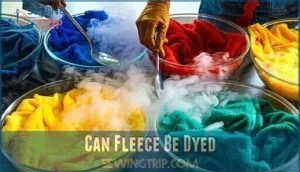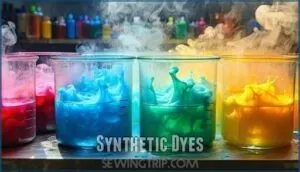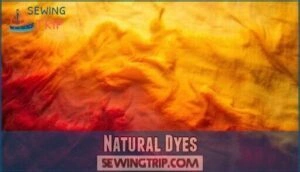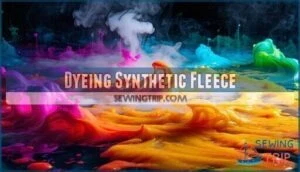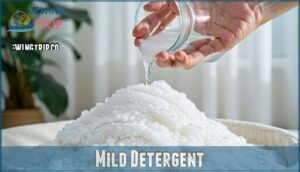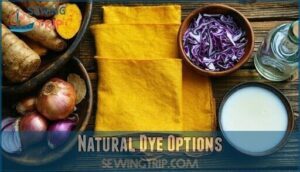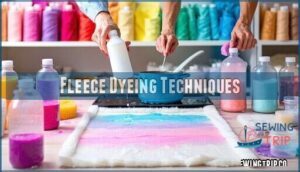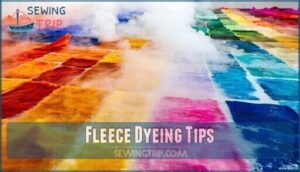This site is supported by our readers. We may earn a commission, at no cost to you, if you purchase through links.
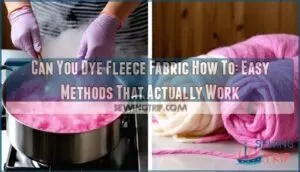
Synthetic fleece (polyester) needs synthetic dyes like Rit DyeMore and high heat, while natural fleece accepts regular fabric dyes at lower temperatures.
Start by identifying your fleece type—check the care label.
Pre-wash to remove sizing and oils.
For synthetic fleece, use stovetop methods with near-boiling water and longer processing times.
Natural fleece can handle gentler approaches with warm water.
The key is matching the right dye chemistry to your fabric’s composition.
Temperature control and proper preparation make the difference between vibrant results and disappointing outcomes that leave you wondering what went wrong, which is why proper preparation is crucial for achieving vibrant results.
Table Of Contents
Key Takeaways
- Check your fleece’s fiber content first – synthetic fleece needs specialized dyes, like Rit DyeMore, while natural fleece works with regular fabric dyes
- Use high heat for synthetic fleece – you’ll need stovetop temperatures around 200°F to penetrate polyester fibers effectively
- Pre-wash and prep properly – remove manufacturing oils and sizing that block dye absorption for better color results
- Test a hidden section first – fleece dyeing results can be unpredictable, so you’ll avoid disappointment by testing before committing to the full project
Dyeing Fleece Fabric
You can definitely dye fleece fabric, but success depends on choosing the right type of dye for your specific fleece material.
Most fleece is made from polyester, which requires synthetic dyes like Rit DyeMore or iDye Poly rather than traditional fabric dyes that work on natural fibers.
Synthetic fleece demands specialized dyes—regular fabric dyes simply won’t stick to polyester fibers.
Choosing Right Dye
Selecting the right dye can make or break your fleece project. The fiber content determines your dye compatibility options—polyester fleece needs synthetic-specific dyes, while natural blends work with traditional options.
Here’s your dye selection roadmap:
- Check the care label for fiber content before buying any dye
- Choose Rit DyeMore or iDye Poly for synthetic fleece like polyester
- Pick fiber-reactive dyes for cotton or natural fleece blends
- Consider color fastness ratings to prevent future fading issues
- Review safety precautions since synthetic fabric dye requires high heat
Dye alternatives like Kool-Aid won’t cut it for dyeing polyester fleece—you need the best fleece dye formulated specifically for synthetic materials to achieve lasting results. Achieving the desired color can be unpredictable, as demonstrated by color variance examples when dyeing synthetics.
Preparing Fleece
Proper preparation makes the difference between dye success and disaster when you dye fleece fabric.
Pre-dye washing removes oils and finishes that block absorption.
Weighing fabric guarantees you’ll have enough dye for complete coverage.
| Preparation Step | Why It Matters |
|---|---|
| Pre-dye washing | Removes manufacturing oils that prevent dye absorption |
| Weighing fabric | Determines correct dye packet quantity needed |
| Fiber identification | Confirms fleece type for proper dye selection |
| Dye testing | Prevents disappointing results on hidden fabric area |
The key steps include pre-dye washing, weighing fabric, fiber identification, and dye testing to ensure a successful dyeing process.
Dyeing Methods
Mastering how to dye fleece fabric requires choosing the right approach for your project.
Each method offers unique advantages for dyeing synthetic fleece at home.
- Stovetop immersion dyeing – Heat water to 200°F with synthetic dyes for even coverage
- Gradient dyeing – Create ombre effects by gradually lowering fabric into dye bath
- Resist techniques – Use tape or wax for patterns before dip dyeing
- Colorfastness testing – Always test small samples first to prevent surprises
Can Fleece Be Dyed
Yes, you can dye fleece, but success depends heavily on fiber composition and material identification. Most fleece is made from 100% polyester, which creates significant dye resistance compared to natural fibers.
Most fleece is polyester—regular dyes won’t stick without special synthetic formulas and high heat.
This synthetic nature means traditional fabric dyes won’t work—you’ll need specialized products designed for synthetic materials. The key to dyeing fleece at home lies in understanding fleece dyeability.
Polyester fleece requires disperse dyes that can penetrate synthetic fibers at high temperatures. Regular Rit dye will barely touch your fleece, leaving you frustrated with faded results. However, products like Rit DyeMore or iDye Poly are formulated specifically for this challenge.
Color fastness varies with synthetic fabrics, making dyeing fleece somewhat unpredictable. You might get vibrant results or subtle color shifts, depending on the fleece’s manufacturing process and existing finish. Blended fleece with natural fiber content offers better dye absorption but creates uneven coloring.
To prepare the fleece, consider that bleach controls odors and may be useful before dyeing. Before starting any dyeing fleece project, test a hidden section to determine how your specific fleece will react.
This simple step saves time and prevents disappointing results with your favorite fleece items, ensuring a successful dyeing process and a better understanding of synthetic fibers.
Fleece Dyeing Materials
You’ll need the right materials to successfully dye fleece fabric, especially since most fleece is made from synthetic polyester fibers.
Your material choices can make or break your dyeing project, so let’s cover what actually works.
Synthetic Dyes
Dyeing polyester fleece transforms tired garments into vibrant favorites when you choose the right synthetic dyes.
These specialized formulas penetrate synthetic fibers where regular dyes fail.
- Rit DyeMore – Designed specifically for polyester fleece with heat-activated color molecules
- iDye Poly – Budget-friendly disperse dyes that deliver consistent color vibrancy
- Commercial disperse dyes – Professional-grade options for maximum durability and fading resistance
Natural Dyes
Several plant-based dyes work well for natural fleece dyeing.
Madder root creates orange to red shades, while walnut hulls produce rich browns.
Turmeric offers bright yellows, though color fastness remains limited.
Natural mordants like alum improve dye uptake and durability.
These eco-friendly options require patience but deliver beautiful, sustainable results for your fleece fabric dyeing projects.
Dyeing Tools
The right tools make all the difference when dyeing fleece. You’ll need a large stainless steel stock pot for heating, protective gloves to shield your hands, and measuring tools for accurate dye ratios.
Essential dyeing supplies include stirring implements, squeeze bottles for precise application, and proper heat sources. Safety gear protects you from chemical fumes during the process.
Many vendors supply fleece dyeing products for this purpose, providing the necessary materials for a successful and safe fleece dyeing experience with the right tools.
Dyeing Synthetic Fleece
Synthetic fleece needs special treatment because regular fabric dyes won’t stick to polyester fibers. You’ll need high-heat methods and synthetic-specific dyes like Rit DyeMore to get lasting color results.
High Heat Method
Heat changes everything when you’re dyeing polyester fleece. The optimal temperature of 200°F+ facilitates dye penetration that room-temperature methods can’t achieve.
This high heat dye technique transforms your fleece dye guide from wishful thinking into reality, ensuring color fastness while preserving fleece texture.
You can find a variety of options for purchasing the right dye.
- Watch synthetic fibers finally surrender to vibrant, lasting color
- Feel confident knowing your project won’t fade after one wash
- Experience the satisfaction of dyeing fleece successfully with professional results
Stovetop Dyeing
Your stovetop becomes the command center for successful fleece fabric dyeing. Fill a large stainless steel pot with three gallons of water, ensuring proper pot size for fabric movement.
Maintain heat control at 200°F while stirring frequency stays consistent every few minutes. Good water quality matters – filtered water prevents mineral interference.
Consider fleece stovetop dye options for vibrant results. Always work near ventilation to manage dye fumes safely during this best dye for fleece process.
Microwave Dyeing
Microwave dyeing offers a quick alternative for fleece fabric dyeing tips when you’re short on time.
This method works best with acid dyes and requires microwave safety precautions.
Use microwave-safe container selection to prevent melting during 1-2 minute heating cycles.
The controlled heat improves dye absorption while maintaining color fastness.
Time adjustments depend on fleece thickness—start small and increase gradually to avoid fiber damage.
Dyeing Natural Fleece
Natural fleece from sheep responds beautifully to traditional fabric dyes, unlike its synthetic counterpart.
You can use cold water methods with natural dyes or standard fabric dyes, making it much easier than dyeing polyester fleece.
Cold Water Dyeing
Cold water dyeing offers a gentler approach for dyeing fleece fabric, especially natural wool fleece.
This method preserves fiber integrity while achieving beautiful colors. You’ll need substantive dyes with high tannin content and proper dye fixatives for maximum color fastness.
Many dyers use common mordants like alum to prepare the yarn.
Cold Water Dyeing Process:
- Soak fleece 12-24 hours in cold dye bath with citric acid for better fiber reactivity
- Use tannin-rich dyes like onion skins or walnut husks that don’t require heat activation
- Add vinegar as fixative to improve color fastness and prevent fading during cold water washing
- Accept limited palette – cold methods produce softer, pastel shades compared to heat dyeing
Mild Detergent
Before dyeing fleece fabric, you’ll need to prep it properly.
Use mild detergent types like wool wash or gentle soap to clean your fleece without harsh chemicals.
Avoid strong detergents that cause residue buildup and affect colorfastness impact.
Rinse thoroughly to maintain softness retention.
Choose eco-friendly options for environmental concerns during your fleece fabric dyeing process.
Natural Dye Options
Nature offers countless plant-based dyes that transform fleece beautifully.
Kitchen scraps like onion skins and avocado pits create stunning food waste dyes, while coffee grounds add rich browns.
These eco-friendly dyeing methods work wonderfully:
- Onion skins produce vibrant yellows and oranges
- Black walnut husks create deep browns without mordants
- Red cabbage yields blues and purples
- Turmeric delivers bright golden hues
Though colorfastness issues exist with some natural options, proper mordant alternatives like vinegar help colors stick, ensuring the use of eco-friendly methods and promoting sustainable practices.
Fleece Dyeing Techniques
You’ll find three main techniques work best for dyeing fleece fabric at home.
Each method gives you different levels of control and color intensity, so you can choose what works for your project and skill level.
Immersion Dyeing
Three immersion dyeing techniques can transform your fleece fabric completely.
First, prepare your dye bath ratio using synthetic dyes for polyester fleece – temperature control at 200°F guarantees proper color saturation.
Gentle agitation effects help achieve even dyeing across the entire garment for professional results.
Fleece owners should also know that they can control odors using small amounts of bleach.
| Technique | Temperature | Time |
|---|---|---|
| Hot Water Bath | 200°F | 30-60 min |
| Constant Stirring | Maintain Heat | Every 5 min |
| Full Submersion | Boiling Point | Throughout Process |
| Cold Water Rinse | Room Temp | Until Clear |
The techniques include Hot Water Bath, Constant Stirring, Full Submersion, and Cold Water Rinse, each with specific requirements for temperature and time to ensure the best results.
Tie Dye Method
Traditional immersion dyeing gives you solid colors, but tie-dye creates stunning pattern variations through strategic scrunching techniques.
You’ll manipulate fleece fabric color change by folding and securing sections with rubber bands.
Here’s your DIY tiedye approach:
- Scrunch and bind damp fleece into desired patterns using rubber bands
- Apply disperse dye directly to sections, ensuring proper dye saturation
- Heat-set in plastic bags at 180°F for ideal color placement
This dyeing fleece tutorial works great for tiedye blanket projects!
Squirt Bottle Method
For targeted application on fleece fabric, squirt bottles offer precision dyeing that’s perfect for small projects.
You’ll create stunning gradient effects and color blending by controlling dye placement exactly where you want it.
This dyeing fleece technique works especially well for accent areas or decorative patterns.
Mix your synthetic dye solution, fill clean squirt bottles, and apply directly to damp fleece to achieve a complete control over your fleece fabric color change results.
Fleece Dyeing Tips
Successfully dyeing fleece takes patience and the right approach, but these essential tips will help you avoid common mistakes.
Understanding color variance, preventing fading, and stopping dye transfer are key to getting professional-looking results every time.
Color Variance
Color variance is a wild card when dyeing fleece fabric. Your results won’t always match the package, and that’s normal for synthetic materials.
Here’s what affects your final color:
- Dye lot differences – Each batch varies slightly in concentration
- Fiber blend effects – Mixed materials create uneven absorption patterns
- Starting color impact – Darker fleece limits your color options substantially
- Temperature fluctuations – Inconsistent heat changes dye penetration rates
When sewing fleece, remember to address seam allowance bulk for a smoother finish.
Fading Prevention
Keep your newly dyed fleece looking fresh by washing in cold water with gentle detergents.
Hot water opens fibers and releases dye, causing color fading faster than you’d like.
Skip the dryer’s high heat – air dry flat away from direct sunlight for UV protection.
These simple dye setting steps help your fleece dyeing techniques pay off long-term, ensuring your fleece remains looking fresh.
Dye Transfer Prevention
Nobody wants their freshly dyed fleece bleeding color onto other clothes.
Start by using cold water for post-dye rinsing until it runs clear. Skip fabric softeners during the first few washes—they can interfere with fixation methods.
When you dye polyester fleece, sealing dye properly prevents color bleeding disasters.
Wash dyed items separately for the first three cycles to master fleece dyeing techniques safely.
Frequently Asked Questions (FAQs)
Can fleece fabric be dyed?
Think dyeing fleece is impossible? You’re in for a surprise!
You can dye 100% polyester fleece, but you’ll need synthetic-specific dyes like Rit DyeMore or iDye Poly, plus high heat on your stovetop to make it work.
What type of fabric cannot be dyed?
You can’t successfully dye fabrics with tight weaves, waterproof coatings, or heavy synthetic blends. Leather, vinyl, and treated outdoor gear resist dye absorption completely.
What fabrics does Rit Dye not work on?
Traditional Rit dye won’t work on synthetic fabrics like polyester, nylon, acrylic, or spandex.
You’ll need Rit DyeMore specifically designed for synthetics, which requires high heat to penetrate these stubborn fibers effectively.
Can I dye a fuzzy blanket?
Don’t worry if your blanket’s synthetic – you can absolutely dye fuzzy fleece blankets! You’ll need special synthetic dyes like Rit DyeMore, high heat, and patience for great results.
How long does fleece take to dry after dyeing?
After dyeing, fleece typically takes 24-48 hours to air dry completely.
You’ll want to lay it flat or hang it in a well-ventilated area, avoiding direct sunlight which can fade your newly dyed colors.
Can you dye fleece blankets and throws?
You can dye fleece blankets and throws, but they’ll need synthetic dyes like Rit DyeMore since most fleece is polyester.
Use stovetop heating to 200°F for proper color penetration and absorption.
Does dyeing fleece affect its fire resistance?
Forget about flames—focus on fleece fibers!
Fire retardant agents are water-based, inert treatments that affect fabric properties.
The dyeing process could compromise any existing flame resistance, requiring re-treatment afterward for safety.
Can you dye patterned or printed fleece?
You can dye patterned fleece, but results will vary wildly.
Existing colors mix with new dye, creating unpredictable shades.
Prints might partially show through or disappear entirely, depending on original colors and fabric composition, which affects the final outcome.
What safety precautions are needed when dyeing fleece?
Always wear protective gloves and face masks when dyeing fleece.
Work in a well-ventilated area since heating synthetic dyes releases chemical fumes.
Use stainless steel pots dedicated to dyeing—never cook in them again.
Conclusion
Dyeing fleece isn’t rocket science, but it does require the right approach.
Whether you’re working with synthetic or natural fleece, success comes down to matching your dye type to your fabric composition.
Remember to check that care label first, pre-wash thoroughly, and control your temperatures carefully.
With proper preparation and the right technique, you’ll transform your fleece from drab to fab, and now you know exactly how to dye fleece fabric—so grab your supplies and start experimenting with a new look!
- https://www.anielskaaniela.com/2025/05/5-best-dyes-for-polyester-fabrics-how.html
- https://threadsmonthly.com/best-fabric-dyes/
- https://www.dylon.co.uk/dyes/how-to/which-fabrics-can-I-dye.html
- https://www.creativesavv.com/2021/04/dyeing-polyester-fleece.html
- https://www.myfrugalhome.com/how-to-redye-fleece/

